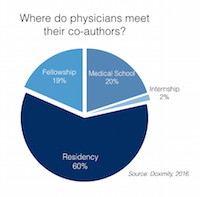This article is contributed by Dr. Mahboob Alam, Doximity Fellow and Assistant Professor of Medicine-Cardiology at Baylor College of Medicine
In medicine, expressing our thoughts and findings in the form of research papers is of utmost importance. Our research helps spread knowledge and may both directly and indirectly impact patient care. Through published research, we learn from each other’s experiences -- whether the outcomes are desired or adverse.
When writing papers, our co-authors are a vital source of ideas and support. Writing a manuscript and getting it through the rigorous process of peer review and publication can be painstaking. Co-authors are closely involved with manuscript from the beginning, and they’re the best peer reviewers one can have. I’ve been fortunate to work with co-authors who are well known in academic medicine. They were essential to our papers’ successes and made each one better, which ultimately led to faster publication.
Since research and co-authorship are so important, it’s worth wondering: When are doctors most likely to meet their co-authors? And how do they shape our trajectory in academia? To find out, let’s take a look at some data.
According to new Doximity research, 60% of co-authors who trained together first did so in residency training. Of the rest, 20% were medical school classmates, 18.5% met during fellowship, and 1.5% met during internship.

This data highlights an important fact about our training as physicians and the paths we take as we advance in our careers. Internship is an extremely busy year of one’s training and, more so, it’s a critical year in which we lay the foundations for our future in clinical medicine.
Based on my personal experience, I was least productive in terms of writing papers during my internship year. This was mostly due to extended work-hours and call schedules. Despite the fact that 20% of my classmates from intern year ended up in the same specialty (cardiovascular medicine), I hardly remember collaborating with one of my co-interns on a research paper or a project. Internship year, however, helped me plan for the future. It also helped me meet seniors and faculty members who were actively engaged in clinical research and who would later become my co-authors.
As I write this, our new interns have recently started and finished their orientation week. The year ahead is going to be a busy one, and the race towards excellence in academic medicine starts on day one. Identifying your co-authors starts right away too! Remember, there’s a high probability you’ll meet your co-authors early in your career. It all starts with an idea that blossoms into a research abstract and ultimately, with the help of right minds, into an outstanding research publication.
